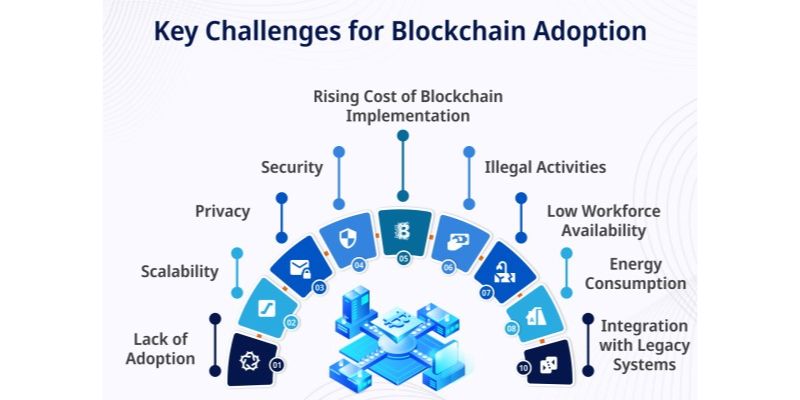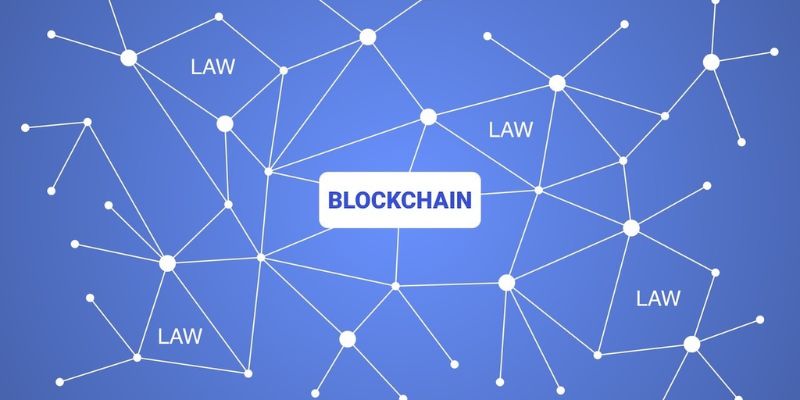**Transforming industries with innovation is no small feat, and the Challenges of adopting blockchain technology in different industries are a critical piece of the puzzle. Each industry faces a unique mix of hurdles, from integrating cutting-edge tech with old systems to making sure new methods meet strict rules. Let’s dive deep into what keeps businesses up at night as they aim to harness the power and potential of blockchain. We’ll break down the tech and scale walls they face, steer through the maze of legal needs and costs, pave the way for more know-how and industry use, and tackle the tough parts of keeping things safe and useful beyond just digital cash. Get ready to gear up for a frank discussion on blockchain’s tough climb and how it’s reshaping the landscape of how we do business.
Understanding the Technological and Scale Barriers to Blockchain Adoption
Delving into Blockchain Scalability Issues
Let’s talk about why making blockchain bigger can be tough. Just like a growing tree might struggle to keep all its branches well-fed, blockchain systems may buckle under too many transactions. Picture a crowded station. If it’s too small, you know it’s hard for trains to come and go smoothly. That’s what happens when lots of people use the blockchain at once. We call this ‘scalability issues.’
Blockchain should be fast and handle much activity, like a top-priced sports car. But right now, it’s more like an old bus on a narrow road, chugging along with too many stops. More activity means blocks get full, like a backpack stuffed with books. This can make everything slow down, and folks get upset when things aren’t quick. It’s hard to make blockchain bigger and faster without changing how secure it is or making it cost too much.
Blockchain needs to be like a bee hive, buzzing with activity but each bee has space to move and work. We’re making progress with new ideas, like ‘sharding.’ That’s like giving each bee its room, so the hive doesn’t get too crowded. But there’s still a lot of work to make it better.
Navigating Legacy Systems Integration
Old and new can be friends, but it’s not always easy. Like trying to play a brand-new video game on an old TV, putting blockchain with old systems in a business can cause headaches. Sometimes, they just don’t speak the same language. This is what we mean by ‘legacy systems integration with blockchain.’
Businesses have been around for years, with computers as old as dinosaurs. That’s what we call ‘legacy systems.’ They’re not ready to talk to new blockchain tech. We need a kind of translator, or bridge, to help them work together.
But it’s tricky. It’s like teaching your grandpa to use a smartphone when he loves his old flip phone. You have to be patient and show him why it’s better. For businesses, it means training people and maybe buying new tools. It takes time, money, and a lot of smart thinking.
In the end, though, it’s worth it. When old and new team up, it’s like having the wisdom of grandpa with the energy of a kid. This makes companies smarter, faster, and ready for the future. We just need to be clever about bringing them together and keeping them safe while they get to know each other. That’s what experts like me help to do. It’s a bit like being a tech matchmaker!

Navigating Regulatory Landscapes and Cost Management
Deciphering Blockchain Regulatory Challenges
When it comes to using blockchain, we must understand the rules. Different places have different rules, which can be tricky. Some rules keep our money safe. Others control how we buy and sell things with digital cash. We need to follow these rules or we might get into trouble. We use blockchain in different ways. Sometimes we use it for health records or to track things we sell. We even use it to buy or sell a house. But with all these uses, we have to be sure we’re not breaking any laws. Every time we use blockchain, we must check the rules.
These rules change often, which can be hard to keep up with. It’s like a game where the rules change while you play. We need people who understand these rules really well. They tell us how to follow them, so we can use blockchain the right way. This is important because we want to be fair and safe when we use this new tech.
Assessing the Financial Implications and Cost Barriers
Money is a big part of using blockchain. It can cost a lot to start. And it takes energy, which also costs money, to keep it going. We also need to make sure our old computer systems can work with it. Sometimes we need new computers or programs, but these can be expensive.
Making sure we can afford it is just the beginning. We also have to think about the money we spend to keep everything running smoothly and safely. It’s like having a car. Not only do you need to buy it, but you also need to pay for gas and fixes. We also need to think about how fast and secure it is when we send money or information. We always want it to be quick and safe.
If we know how much it costs and how it helps us, we can make better choices. Sometimes, we find out that what it offers is worth more than the cost. Other times, we might decide to wait until it costs less. Plus, we have to teach everyone how to use it. That takes time and money, too. But once we learn, it can make things better and faster for everyone.
In conclusion, using blockchain means we must think about the rules and the money. We want to do it right and not spend too much. We also want to make sure everyone knows how to use it. It’s like planting a seed in a garden. We have to care for it, so it can grow strong and be really useful one day.

Driving Adoption Through Knowledge and Industry Application
Cultivating Blockchain Education in the Workforce
In many places, we don’t learn enough about blockchain at work. We must teach folks about it. Blockchain isn’t just for tech experts! Everyone should grasp its basics. We need education programs. People can learn about blockchain’s building blocks. They learn how it can solve real-world problems. Banks use it for quick, safe money transfers. In healthcare, it keeps patient data safe and sound. Knowing this can help us embrace blockchain, not fear it.
Let’s think about this: How can we teach workers about blockchain? First, show them how it’s used today. Like tracking goods from factory to store. People need to see how blockchain can make tasks easier and safer. Next, train them in skills needed to work with blockchain. Explain smart contracts and why they matter. Teach them about setting up blockchain networks. This can help workers feel ready and eager to use blockchain in their jobs.
Fostering Interoperability Across Industries
Getting different systems to work together is tough. But it’s key for blockchain’s future. Say one store uses blockchain to track apples. And a trucker uses another system to transport them. The two systems should talk to each other. This makes it easy to see where the apples are. The goal is to link up different industries on one blockchain. That way, everyone is on the same page.
Another question is: What are the barriers to blockchain working with other systems? Sometimes two blockchains speak different ‘languages.’ It’s like trying to fit a round peg in a square hole. We need people to create rules and tools to help them ‘talk’ to each other. With these, we can avoid delays. We can help businesses trust blockchain to share info without a hitch. By joining forces, industries can do more with less hassle.
In summary, we bridge gaps in knowledge and systems to grow blockchain use. We teach our teams about blockchain’s power. We get different systems to work as one. With these steps, we get closer to blockchain being a part of daily life in all our jobs. It seems daunting, but it’s doable with the right approach, and I’m here to guide the way.

Addressing Security and Use Case Specific Hurdles
Enhancing Blockchain Security Measures
Securing a blockchain system is tricky. Bad actors look for any weak spot. We tackle blockchain security concerns head-on. But how secure are blockchains? In short, they’re very secure thanks to complex math and consensus mechanisms. Still, no system is foolproof. We must stay ahead of the curve to fend off threats.
We start with the basics—strong encryption and secure networks. But we don’t stop there. We use cutting-edge tech like zero-knowledge proofs. This way, users share data without exposing the data itself. It’s like showing a bouncer your ID without revealing your address. We update our security for the newest risks. So yes, hackers are smart. But we aim to be smarter.
Expanding Blockchain Utility Beyond Cryptocurrency
Blockchain is more than Bitcoin. Its uses reach far and wide. People ask, what more can it do beyond coins? A lot, actually. Let’s talk about smart contracts. They’re like vending machines. You put something in—like data or money—and out pops a contract, no middleman needed.
These digital agreements can change industries. Imagine tracking a mango’s journey from tree to store. Every step: recorded on the blockchain. This means fewer lost goods and better safety. We’re seeing blockchain pop up in healthcare too. Securely sharing patient records can save lives. It’s all about trust without borders or boundaries.
Or take real estate. It’s tangled in paperwork and fees. Blockchain can simplify it, making buying a home as easy as sending an email. No jargon, just homes changing hands swiftly and safely.
Each sector has its hurdles. For banks, it’s about accepting the new wave of finance. In retail, it’s convincing customers it’s safe and simple. In energy, it’s managing vast amounts of data without wasting power. But don’t worry—we’re dealing with these, one by one.
So you see, blockchain is a chameleon. It fits in many places, changing its colors to match. With time and teamwork, we’ll push past these hurdles. We’ll bring blockchain’s trust and efficiency to all corners, not just in finance. And I’m on the ground floor, tools in hand, ready to build that future with you.
Just remember, as much as we push for progress, we can’t rush it. We learn and grow, unfolding blockchain’s potential carefully. We’ll get there, with the right tools, minds, and spirit. I’m excited for what’s ahead—are you?
We’ve covered a lot in our journey to understand blockchain’s growing pains. We tackled the big hurdles like scaling the tech, fitting it with old systems, and learning the rules that govern it. We also talked money—what it costs to use blockchain right. And we can’t forget education; it’s key to getting more industries to adopt this tech. Last up, we looked at how to keep blockchain safe and useful for more than just digital cash.
So, what’s my final take? Well, blockchain is like a teen—full of promise but facing some tough challenges. It’s clear that if we teach it well, spend wisely, and play by the rules, blockchain could really change the game. Every industry could see a revolution. But we have to work together, break down barriers, and stay open to learning. That’s how we’ll make blockchain work for everyone. Keep these points in mind, and let’s push this tech to new heights.
Q&A :
What are common obstacles faced by industries implementing blockchain?
The incorporation of blockchain technology across various sectors is frequently constrained by several key challenges. These include scalability and transaction speed limitations, which can hinder performance and efficiency compared to traditional databases. Additionally, industries grapple with the complexity of integrating blockchain with existing systems, requiring substantial technical expertise and potentially costly infrastructure improvements. Security concerns also arise, given the need to safeguard against cyber threats in an environment that promotes decentralization and immutable record-keeping.
How does the cost factor into adopting blockchain in business operations?
Industries considering blockchain integration often encounter cost-related barriers. Firstly, the initial investment for setting up a blockchain solution can be significant, covering technology development, infrastructure, and skilled personnel. Ongoing operational costs also come into play, stemming from energy consumption, especially for proof-of-work systems, and maintenance expenses for network stability and updates. Therefore, organizations must thoroughly assess the long-term financial implications before proceeding with blockchain adoption.
What are the regulatory and compliance challenges with blockchain?
Blockchain deployment across various industries must navigate a complex and often unclear regulatory landscape. As a jurisdiction-agnostic technology, blockchain raises questions surrounding legal compliance, data privacy, taxation, and cross-border transactions. Industries must stay abreast of emerging regulations and ensure that their blockchain applications adhere to local and international laws, which may entail significant legal oversight and adaptability to evolving legal standards.
Can blockchain adapt to the specific needs of different industries?
Blockchain technology, while versatile, comes with the challenge of being a one-size-fits-all solution. Different industries have unique demands, requiring tailored blockchain applications that suit specific operational workflows, transaction types, security requirements, and integration with industry-specific systems. Developing and customizing blockchain platforms to meet these specialized needs necessitates a deep understanding of the particular industry, which can be resource-intensive and time-consuming.
How does blockchain technology impact data privacy and security in industries?
While blockchain is heralded for its security advantages, it also introduces data privacy and control concerns that various industries must address. The immutable nature of blockchain means that once data is entered, it cannot be altered or deleted, posing potential issues with data rectification and privacy laws such as GDPR. Additionally, the decentralized aspect of blockchain requires industries to establish robust security protocols to prevent unauthorized access and ensure the secure handling of sensitive or proprietary information.



